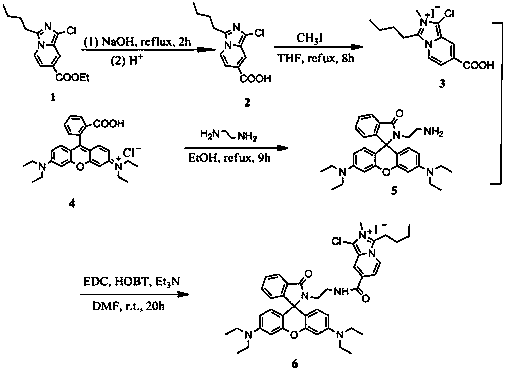Ratio-type pH fluorescent probe for water-soluble localization of lysosomes, its preparation method, application and test method
A technology of fluorescent probes and lysosomes, applied in the field of ratiometric pH fluorescent probes, can solve problems affecting the accuracy of detection results, achieve significant changes in fluorescence intensity, strong anti-interference ability, and improve detection accuracy
- Summary
- Abstract
- Description
- Claims
- Application Information
AI Technical Summary
Problems solved by technology
Method used
Image
Examples
Embodiment 1
[0106] Prepare 20 mL of the above fluorescent probe RMPM (10 μM) at different pH values (ethanol / Britton--Robinson buffer solution, 40 mM acetic acid, phosphoric acid, boric acid, 1:4, volume ratio), and test the fluorescence spectrum by fluorescence spectrophotometry . figure 2 (a) and the fluorescent intensity ratio (I) of the probe in the pH value (5.6-7.2) region 580 / I 426 ) figure 2 (b).
[0107] The results show that: the ratiometric pH fluorescent probe used for water-soluble localization of lysosomes, that is, the terminal compound RMPM, has a significant change in fluorescence intensity in solutions with a pH of 5.8 and 6.8, and the fluorescence emission ratio I 580 / I 426 It reached the peak at 4 min and remained stable at room temperature, which indicated that RMPM can respond quickly to pH changes with high detection accuracy. ( figure 2 , 4 )
Embodiment 2
[0109]Add AgNO respectively in the solution (ethanol / Britton-Robinson buffer solution, 40mM acetic acid, phosphoric acid, boric acid, 1:4, volume ratio) containing pH fluorescent probe RMPM (10 μ M) under the condition of pH value 5.6 and 7.2, Al(NO3)3, Ba(NO3)2, Cd(NO3)2, Co(NO3)2, Cu(NO3)2, Fe(NO3)3, HgCl2, Ni(NO3)2, Pb(NO3)2, The aqueous solution of Zn(NO3)2, the concentration of all metal cations is 100 μ M, test the fluorescence intensity ratio I in the solution that contains different metal ions 580 / I 426 (λ ex = 340nm, image 3 ).
[0110] The results show that the ratiometric pH fluorescent probe used for water-soluble localization of lysosomes, namely the terminal compound RMPM, has almost no response to the above metal ions under the conditions of pH = 5.6 and pH = 7.2, which proves that the probe is sensitive to H + Has high selectivity. The probe RMPM has strong anti-interference ability to common metal ions.
Embodiment 4
[0112] Hela cells were incubated with probe RMPM (1, 2 or 5 μM) at 37°C for 2 h. Observed under a confocal laser microscope. The excitation wavelength is fixed at 405nm, and the emission bands are the fluorescence images of the blue channel (400-555 nm) and the fluorescence images of the red channel (560-700 nm). Both the blue and red fluorescence intensities in Hela cells increased with the increase of the probe concentration, which indicated that the ratiometric pH fluorescent probe for water-soluble localization of lysosomes, the terminal compound RMPM, had the ability to stain living cells ( Figure 5 ).
PUM
| Property | Measurement | Unit |
|---|---|---|
| melting point | aaaaa | aaaaa |
Abstract
Description
Claims
Application Information
 Login to View More
Login to View More - R&D
- Intellectual Property
- Life Sciences
- Materials
- Tech Scout
- Unparalleled Data Quality
- Higher Quality Content
- 60% Fewer Hallucinations
Browse by: Latest US Patents, China's latest patents, Technical Efficacy Thesaurus, Application Domain, Technology Topic, Popular Technical Reports.
© 2025 PatSnap. All rights reserved.Legal|Privacy policy|Modern Slavery Act Transparency Statement|Sitemap|About US| Contact US: help@patsnap.com



